Geochemical Assessment of Mineral Resource Potential in a Hg-Sb-Pb-Zn Mining Area: The Almadén and Guadalmez Synclines (South-Central Spain)
Abstract
:1. Introduction
2. Materials and Methods
2.1. Sampling
2.2. Sample Preparation and Analysis
2.3. Statistical Analyses and Mapping
3. Results and Discussion
3.1. Pedological Parameters
3.2. Major and Trace Elements
3.3. Statistical Treatment
3.4. Spatial Distribution
3.5. Discussion
4. Conclusions
Supplementary Materials
Author Contributions
Funding
Institutional Review Board Statement
Data Availability Statement
Conflicts of Interest
References
- Hernández, A.; Jébrak, M.; Higueras, P.; Oyarzun, R.; Morata, D.; Munhá, J. The Almadén mercury mining district, Spain. Miner. Depos. 1999, 34, 539–548. [Google Scholar] [CrossRef]
- Almela, A.; Alvarado, M.; Coma, J.; Felgeroso, C.; Quintero, I. Estudio geológico de la región de Almadén. Boletín Del Inst. Geológico Y Min. De España 1962, 73, 193–327. [Google Scholar]
- García-Sansegundo, J.; Álvarez, S.L.; Ortega, E. Mapa Geológico Nacional a Escala 1:50.000. Hoja nº 808 (Almadén); IGME: Madrid, Spain, 1987. [Google Scholar]
- García-Sansegundo, J.; Álvarez, S.L.; Ortega, E. Memoria Explicativa de la Hoja nº 808, (Almadén). Mapa Geológico de España, Escala 1:50.000, 2a Serie, Plan MAGNA; IGME: Madrid, Spain, 1987; pp. 11–25, NIPO 232-87-007-3; Available online: http://info.igme.es/cartografiadigital/datos/magna50/memorias/MMagna0808.pdf (accessed on 8 February 2022).
- Higueras, P.; Oyarzun, R.; Morata, D. Intraplate mafic magmatism, degasification, and deposition of mercury: The giant Almadén Hg deposit (Spain) revisited. Ore Geol. Rev. 2013, 51, 93–102. [Google Scholar] [CrossRef] [Green Version]
- Gumiel, P. Metalogenia de Los Yacimientos de Antimonio de la Península Ibérica. Ph.D. Thesis, Universidad de Salamanca—Facultad de Ciencias, Salamanca, Spain, 1982; pp. 217–223. Available online: https://www.researchgate.net/profile/PGumiel/publication/292411068_Metallogenia_de_los_yacimientos_de_antimonio_de_la_Peninsula_Iberica/links/56ae813808ae19a385162fe3/Metallogenia-de-los-yacimientos-de-antimonio-de-la-Peninsula-Iberica.pdf (accessed on 5 February 2022).
- Gumiel, P.; Arribas, A. Antimony deposits in the Iberian Peninsula. Econ. Geol. 1987, 82, 1453–1463. [Google Scholar] [CrossRef]
- Lorenzo, S.; Martín Herrero, D.; Valverde, M.F. Memoria Explicativa de la Hoja nº 807 (Chillón). Mapa Geológico de España, Escala 1:50.000, 2a Serie, Plan MAGNA; IGME: Madrid, Spain, 2005; pp. 92–93. ISBN 84-7840-583-6. [Google Scholar]
- Palero, F.J.; Both, R.A.; Arribas, A.; Boyce, A.J.; Martín-Izard, A.M. Geology and metallogenic evolution of the polymetallic deposits of the Alcudia Valley mineral field, Eastern Sierra Morena, Spain. Econ. Geol. 2003, 98, 577–605. [Google Scholar] [CrossRef]
- Soldevila, J. Estudio geológico estructural de la terminación occidental del sinclinal de Almadén. Bol. Geol. Min. 1983, 94, 93–105. [Google Scholar]
- Rodríguez-Pevida, L.S.; Mira, M.; Ortega, E. Mapa Geológico Nacional a Escala 1:50.000. Hoja nº 833 (Hinojosa del Duque); IGME: Madrid, Spain, 1990. [Google Scholar]
- Jébrak, M.; Higueras, P.L.; Marcoux, E.; Lorenzo, S. Geology and geochemistry of high-grade, volcanic rock-hosted, mercury mineralisation in the Nuevo Entredicho deposit, Almadén district, Spain. Miner. Depos. 2002, 37, 421–432. [Google Scholar] [CrossRef]
- Higueras, P.; Oyarzun, R.; Munhá, J.; Morata, D. The Almadén metallogenic cluster (Ciudad Real, Spain): Alkaline magmatism leading to mineralization process at an intraplate tectonic setting. Rev. De La Soc. Geológica De España 2000, 13, 105–119. [Google Scholar]
- García Alcalde, J.L.; Arbizu, M.A.; Alonso, M.V.P.; López, S.G. El límite Devónico Carbonífero en el área de Guadalmez-Santa Eufemia (Provincias de Ciudad Real y Córdoba, Sierra Morena, España); I Congreso Geológico de España: Segovia, Spain, 1984; Volume 1, pp. 421–430. ISBN 84-500-9835-1. [Google Scholar]
- Villaseca, C.; Orejana, D.; Higueras, P.; Pérez-Soba, C.; Serrano, J.G.; Lorenzo, S. The evolution of the subcontinental mantle beneath the Central Iberian Zone: Geochemical tracking of its mafic magmatism from the Neoproterozoic to the Cenozoic. Earth-Sci. Rev. 2022, 228, 103997. [Google Scholar] [CrossRef]
- Salminen, R.; Batista, M.J.; Bidovec, M.; Demetriades, A.; De Vivo, B.; Lima, A. Foregs—Geochemical Atlas of Europe. Part 1. Background Information, Methodology, and Maps; Geological Survey of Finland: Espoo, Finland, 2005; ISBN 951-690-913-2. [Google Scholar]
- IGME. Geochemical Atlas of Spain (Atlas Geoquímico de España); Instituto Geológico y Minero de España: Madrid, Spain, 2012. [Google Scholar]
- Jiménez-Ballesta, R.; Bueno, P.; Rubí, J.; Giménez, R. Pedo-geochemical baseline content levels and soil quality reference values of trace elements in soils from the Mediterranean (Castilla la Mancha, Spain). Cent. Eur. J. Gorski. 2010, 2, 441–454. [Google Scholar] [CrossRef]
- Bravo, S.; García-Ordiales, E.; García-Navarro, F.J.; Amorós, J.A.; Pérez-de-los-Reyes, C.; Jiménez-Ballesta, R.; Esbrí, J.M.; García-Noguero, E.M.; Higueras, P. Geochemical distribution of major and trace elements in agricultural soils of Castilla-La Mancha (Central Spain). Finding criteria for baselines and delimiting regional anomalies. Environ. Sci. Pollut. Res. 2019, 26, 3100–3114. [Google Scholar] [CrossRef] [PubMed]
- Climate-Data ORG. Climate Almadén. 2022. Available online: https://en.climate-data.org/europe/spain/castile-la-mancha/almaden-46958/ (accessed on 29 January 2022).
- Garcia-Ordiales, E.; Covelli, S.; Rico, J.M.; Roqueñí, N.; Fontolan, G.; Flor-Blanco, G.; Cienfuegos, P.; Loredo, J. Occurrence and speciation of arsenic and mercury in estuarine sediments affected by mining activities (Asturias, northern Spain). Chemosphere 2018, 198, 281–289. [Google Scholar] [CrossRef] [PubMed]
- Udden-Wentworth, C.K. A scale of grade and class terms of clastic sediments. J. Geol. 1922, 30, 377–392. [Google Scholar] [CrossRef]
- ASTM. Annual Book of ASTM Standards; International Standard Worldwide; American Society Testing of Materials: West Conshohocken, PA, USA, 2002; Volumes 04.08–04.09. [Google Scholar]
- Zagal, E.; Sadzawka, A. Protocolo de Métodos de Análisis Para Suelos y Lodos. Universidad de Concepción Facultad de Agronomía Chillán y Miembro Comisión de Normalización y Acreditación, Sociedad Chilena de la Ciencia del Suelo. Elaborado con la Participación de la Comisión de Normalización y Acreditación de la Sociedad Chilena de la Ciencia Del Suelo Por Encargo Del Servicio Agrícola y Ganadero. 2007, pp. 28–30. Available online: http://www.sag.cl/sites/default/files/METODOS_LODOS_SUELOS.pdf (accessed on 21 February 2022).
- Esbrí, J.M.; Rivera, S.; Tejero, J.; Higueras, P.L. Feasibility study of fluorescent lamp waste recycling by thermal desorption. Environ. Sci. Pollut. Res. 2021, 28, 61860–61868. [Google Scholar] [CrossRef] [PubMed]
- Saupé, F. Geology of the Almadén mercury deposit, Province of Ciudad Real, Spain. Econ. Geol. 1990, 85, 482–510. [Google Scholar] [CrossRef]
- Higueras, P.; Oyarzun, R.; Biester, H.; Lillo, J.; Lorenzo, S. A first insight into mercury distribution and speciation in soils from the Almadén mining district, Spain. J. Geochem. Explor. 2003, 80, 95–104. [Google Scholar] [CrossRef]
- Higueras, P.; Oyarzun, R.; Lillo, J.; Hernández, J.C.S.; Molina, J.A.; Esbrí, J.M.; Lorenzo, S. The Almadén district (Spain): Anatomy of one of the world’s largest Hg-contaminated sites. Sci. Total Environ. 2006, 356, 112–124. [Google Scholar] [CrossRef]
- Esbrí, J.M.; Bernaus, A.; Ávila, M.; Kocman, D.; García-Noguero, E.M.; Guerrero, B.; Gaona, X.; Álvarez, R.; Perez-Gonzalez, R.; Valiente, M.; et al. XANES speciation of mercury in three mining districts—Almadén, Asturias (Spain), Idria (Slovenia). J. Synchrotron Radiat. 2010, 17, 179–186. [Google Scholar] [CrossRef] [Green Version]
- Martínez-Coronado, A.; Oyarzun, R.; Esbrí, J.M.; Llanos, W.; Higueras, P. Sampling high to extremely high Hg concentrations at the Cerco de Almadenejos, Almadén mining district (Spain): The old metallurgical precinct (1794 to 1861 AD) and surrounding areas. J. Geochem. Explor. 2011, 109, 70–77. [Google Scholar] [CrossRef] [Green Version]
- Fernández-Martínez, R.; Esbrí, J.M.; Higueras, P.; Rucandio, I. Comparison of mercury distribution and mobility in soils affected by anthropogenic pollution around chloralkali plants and ancient mining sites. Sci. Total Environ. 2019, 671, 1066–1076. [Google Scholar] [CrossRef]
- Higueras, P.; Oyarzun, R.; Lunar, R.; Sierra, J.; Parras, J. The Las Cuevas mercury deposit, Almadén district (Spain): Unusual case of deep-seated advanced argillic alteration related to mercury mineralization. Miner. Depos. 1999, 34, 211–214. [Google Scholar] [CrossRef]
- Esbrí, J.M.; Monsuy, C.; Rivera, S.; Madrid-Illescas, M.; Gonzalez-Valoys, A.; García-Noguero, E.; Thouin, H.; Maguregui, M.; Battaglia-Brunet, F.; Gloaguen, E.; et al. Evaluation of antimony availability in a mining context: Impact for the environment, and for mineral exploration and exploitation. Chemosphere 2022, 311, 137086. [Google Scholar] [CrossRef] [PubMed]
- Wold, S.; Esbensen, K.; Geladi, P. Principal component analysis. Chemomet. Intell. Lab. Syst. 1987, 2, 37–52. [Google Scholar] [CrossRef]
- Weissmannová, H.D.; Pavlovský, J.; Chovanec, P. Heavy metal Contaminations of Urban soils in Ostrava, Czech Republic: Assessment of Metal Pollution and using Principal Component Analysis. Int. J. Environ. Res. 2015, 9, 683–696. [Google Scholar]
- Esbensen, K.H.; Geladi, P. Principles of proper validation: Use and abuse of re-sampling for validation. J. Chemom. 2010, 24, 168–187. [Google Scholar] [CrossRef]
- Reimann, C.; Filxmoser, P.; Garret, R.G. Factor analysis applied to regional geochemical data: Problems and possibilities. Appl. Geochem. 2002, 17, 185–206. [Google Scholar] [CrossRef]
- Kumru, M.N.; Bakac, M. R-mode factor analysis applied to the distribution of elements in soils from the Aydın basin, Turkey. J. Geochem. Explor. 2003, 77, 81–91. [Google Scholar] [CrossRef]
- Helba, H.A.; Khalil, K.I.; El-Farnawany, H.M.; El-Raghy, S.A. Stream sediment geochemical exploration for gold in Central Eastern Desert, Egypt: Application of the concentration-number fractal model, factor analysis, and geochemical mineralization probability index. Geochemistry 2021, 81, 125811. [Google Scholar] [CrossRef]
- Palero, F.J.; Martin-Izard, A.; Prieto, M.Z.; Mansilla-Plaza, L. Geological context and plumbotectonic evolution of the giant Almadén Mercury Deposit. Ore Geol. Rev. 2015, 64, 71–88. [Google Scholar] [CrossRef]
- Martins-Ferreira, M.A.C.; Campos, J.E.G.; Pires, A.C.B. Near-mine exploration via soil geochemistry multivariate analysis at the Almas gold province, central Brazil: A study case. J. Geochem. Explor. 2017, 173, 52–63. [Google Scholar] [CrossRef]
- Wu, R.; Chen, J.; Zhao, J.; Chen, J.; Chen, S. Identifying geochemical anomalies associated with gold mineralization using factor analysis and spectrum–area multifractal model in laowan district, qinling-dabie metallogenic belt, central China. Minerals 2020, 10, 229. [Google Scholar] [CrossRef] [Green Version]
- Ouchchen, M.; Boutaleb, S.; Abia, E.H.; El Azzab, D.; Miftah, A.; Dadi, B.; Echogdali, F.Z.; Mamouch, Y.; Pradhan, B.; Santosh, M.; et al. Exploration targeting of copper deposits using staged factor analysis, geochemical mineralization prospectivity index, and fractal model (Western Anti-Atlas, Morocco). Ore Geol. Rev. 2022, 143, 104762. [Google Scholar] [CrossRef]
- Palero, F.J. Aspectos geológicos y metalogénicos de los yacimientos de mercurio del distrito de Almadén (Ciudad Real). Re-Metallica 2012, 19, 3–25. [Google Scholar]
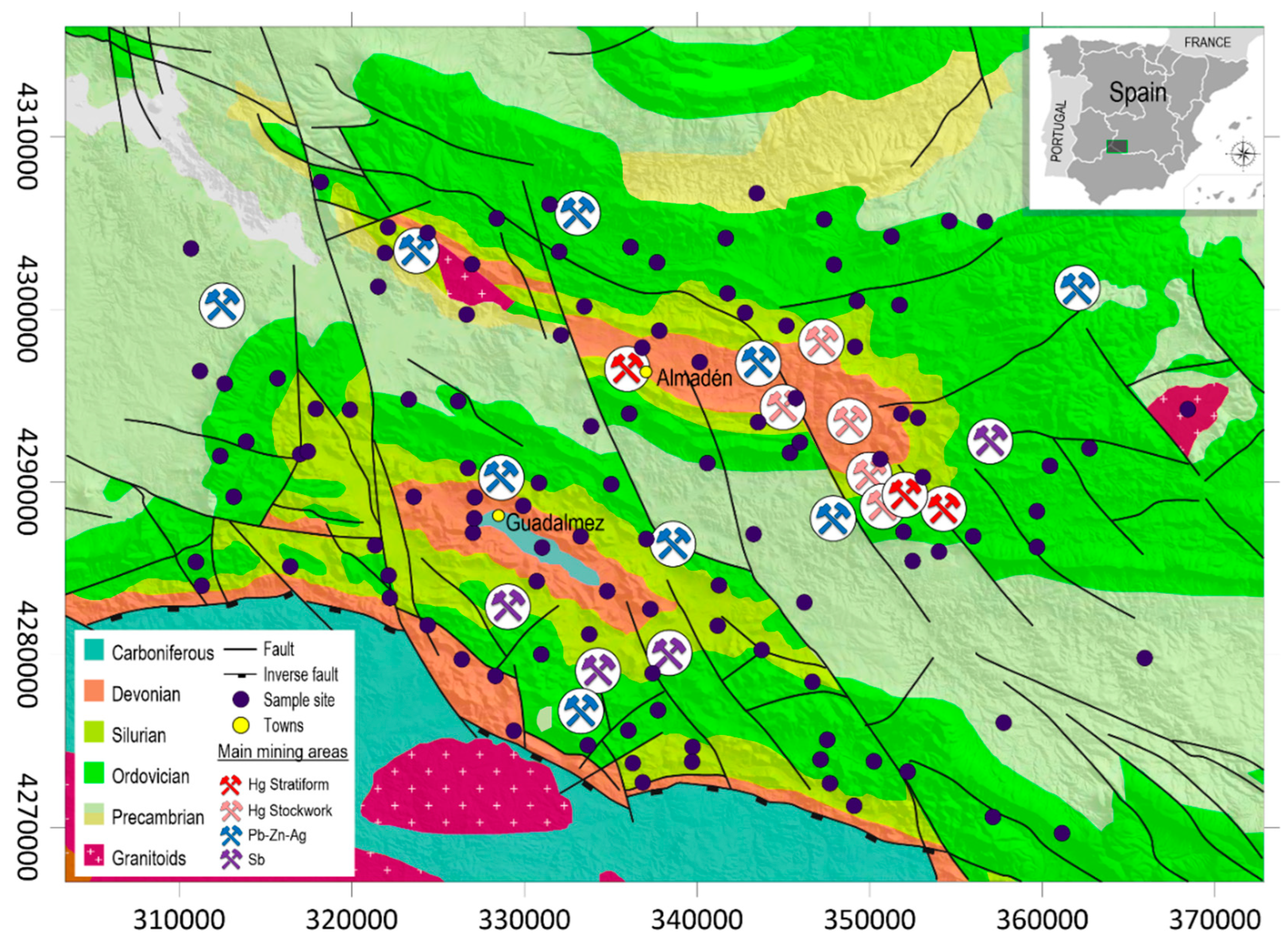
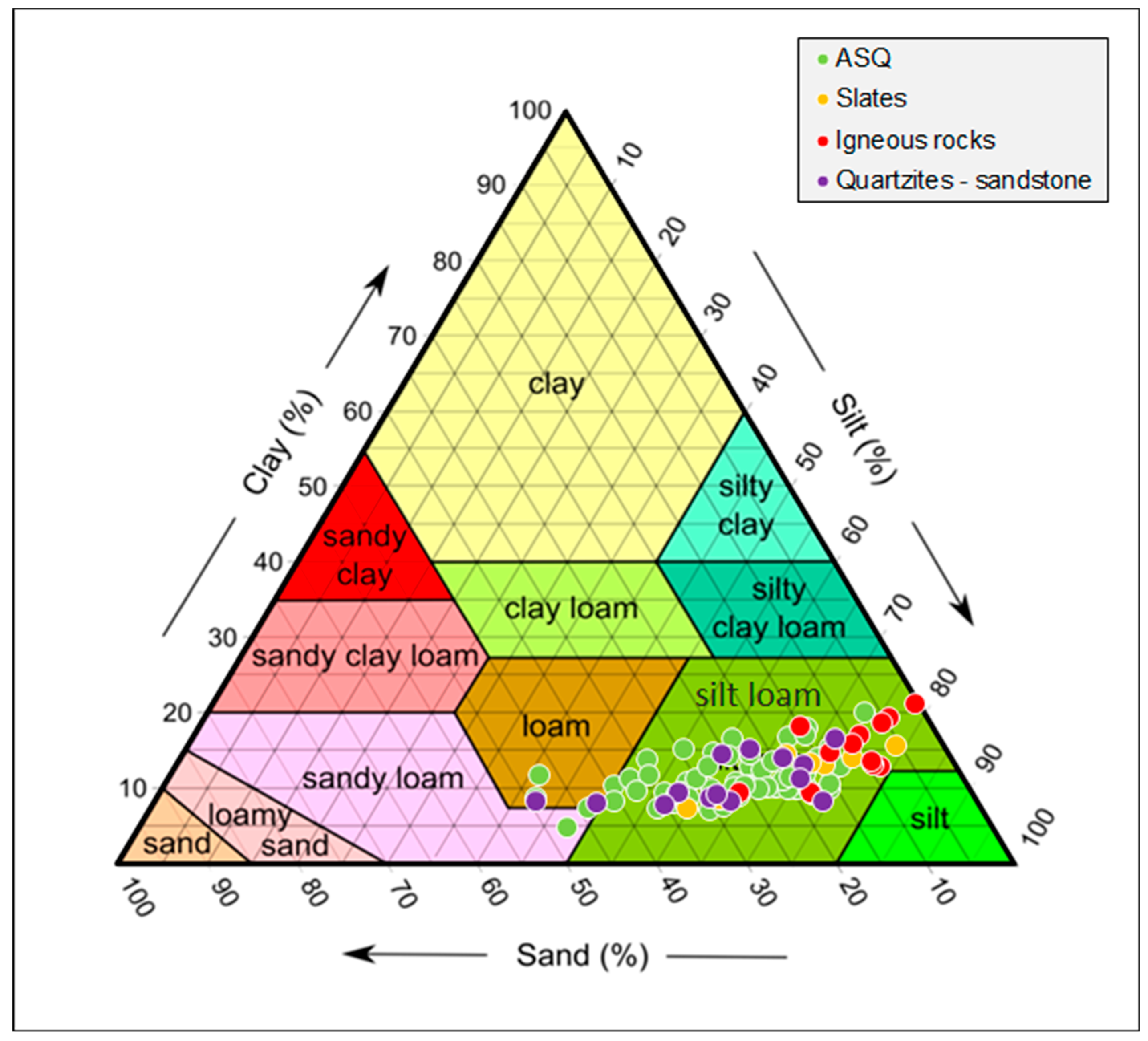
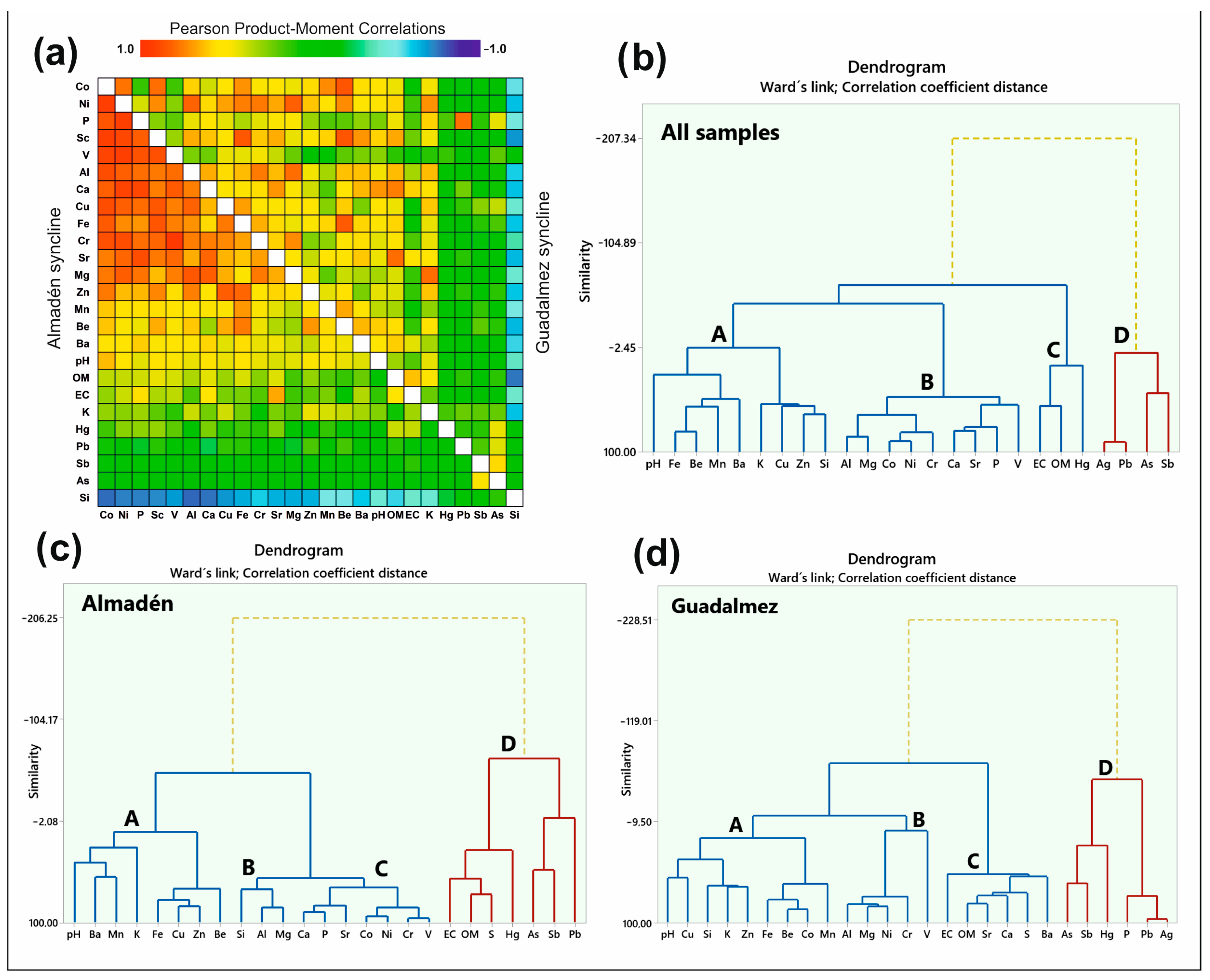
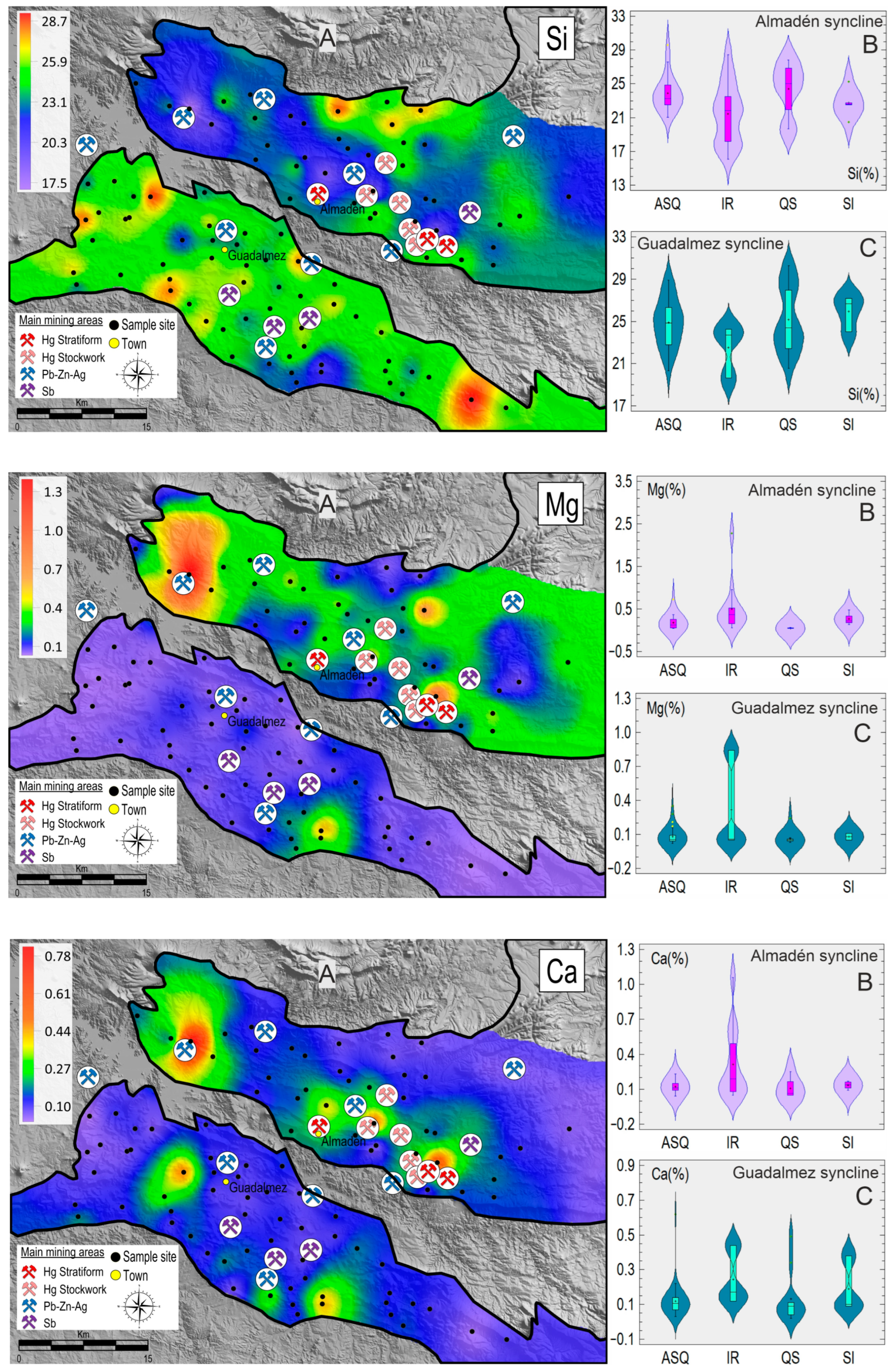
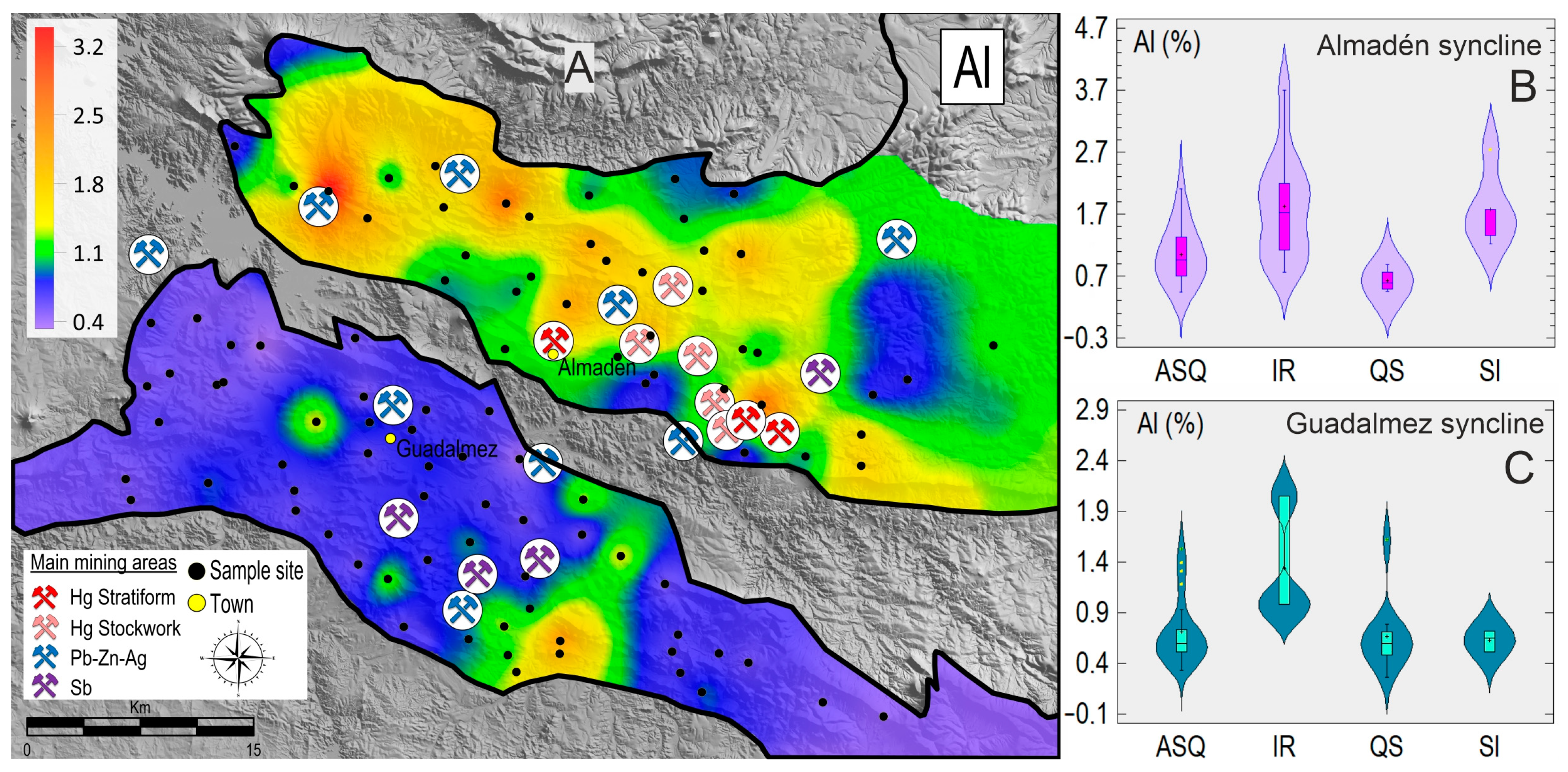
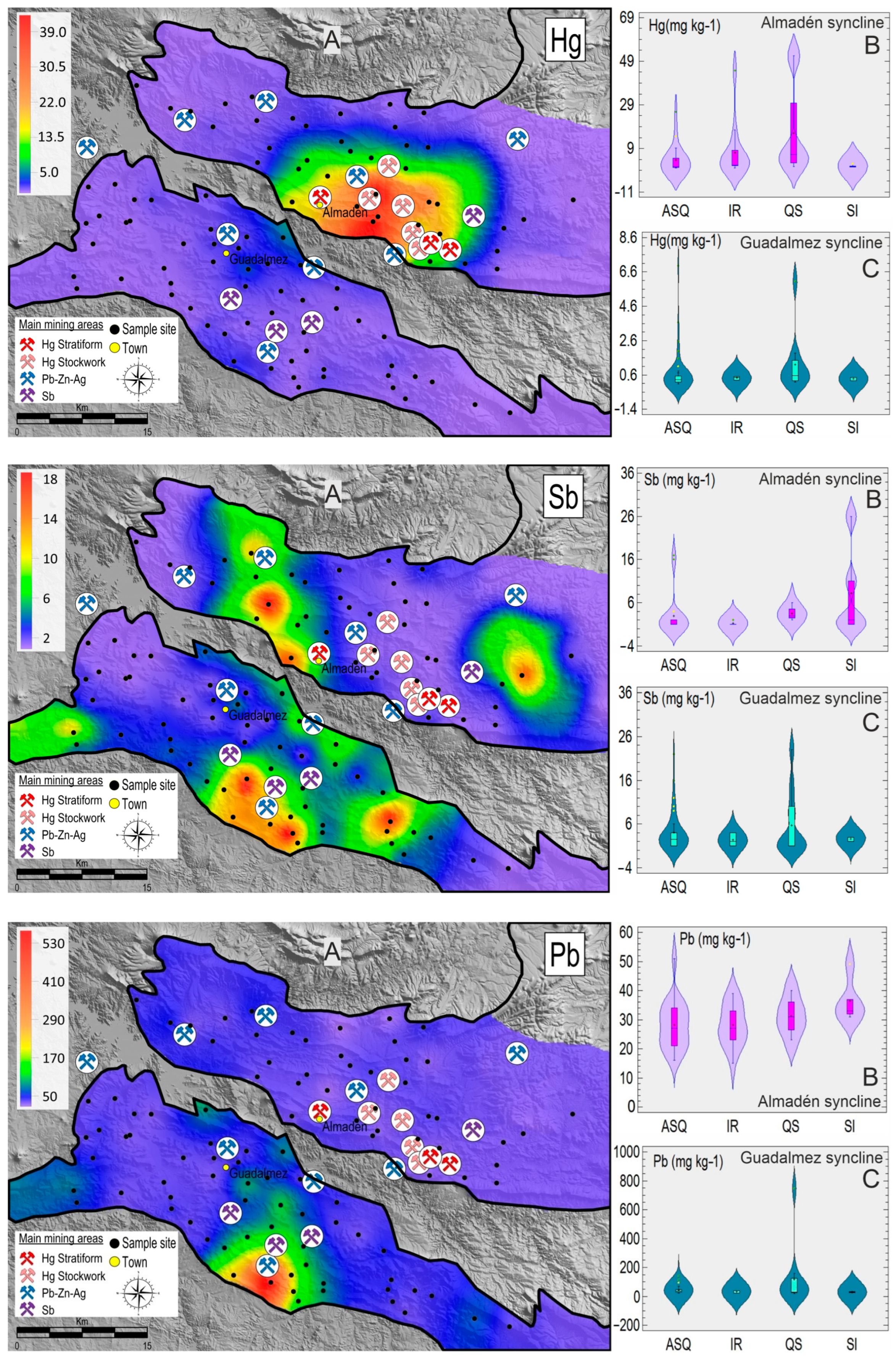

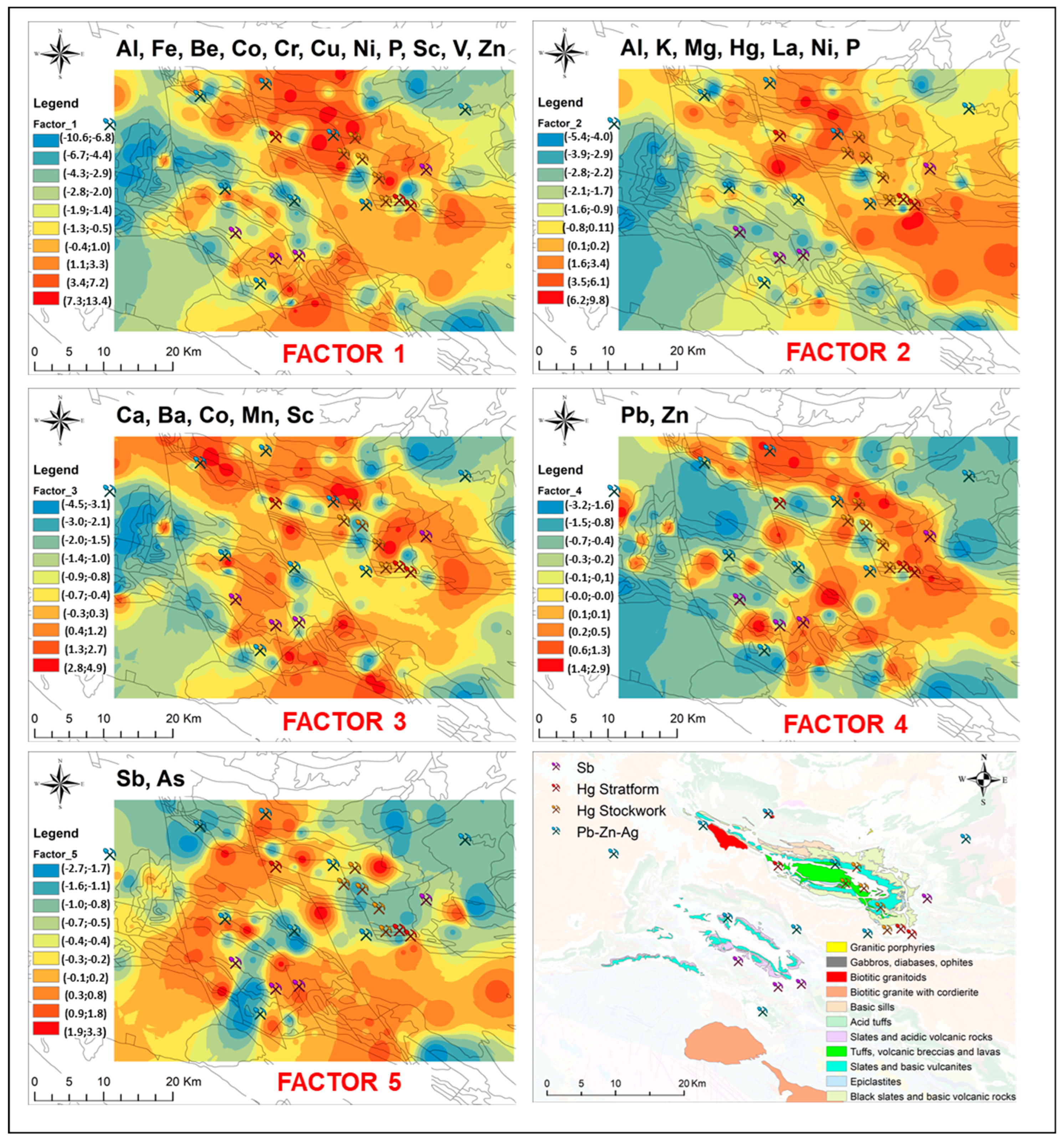
| Variable | Average | SD | VC | Minimum | Maximum |
|---|---|---|---|---|---|
| All data | |||||
| pH | 6.1 | 0.5 | 8.3 | 4.5 | 7.8 |
| EC (µS cm−1) | 30.0 | 20.0 | 47.9 | 10.0 | 110.0 |
| SOM (%) | 4.9 | 1.8 | 36.9 | 1.5 | 13.3 |
| Almadén syncline | |||||
| pH | 6.0 | 0.5 | 8.2 | 4.8 | 7.0 |
| EC (µS cm−1) | 30.0 | 20.0 | 50.4 | 20.0 | 110.0 |
| SOM (%) | 5.5 | 2.1 | 37.1 | 1.5 | 13.3 |
| Guadalmez syncline | |||||
| pH | 6.1 | 0.5 | 8.5 | 4.5 | 7.8 |
| EC (µS cm−1) | 30.0 | 10.0 | 44.1 | 10.0 | 90.0 |
| SOM (%) | 4.4 | 1.5 | 34.4 | 1.9 | 8.9 |
| Unit | Average | SD | VC | Min | Max | Ref. values Spanish soils [17] | Ref. values in Castilla–La Mancha soils [18] | |
|---|---|---|---|---|---|---|---|---|
| Al | % | 1.0 | 0.6 | 59.2 | 0.3 | 3.7 | 6.2 | --- |
| Ca | % | 0.2 | 0.2 | 100.9 | 0.1 | 1.1 | 5.3 | --- |
| Fe | % | 3.5 | 1.7 | 49.4 | 0.6 | 8.0 | 3.0 | --- |
| K | % | 0.1 | 0.1 | 48.6 | 0.1 | 0.3 | 1.9 | --- |
| Mg | % | 0.2 | 0.3 | 144.2 | 0.1 | 2.3 | 0.9 | --- |
| Si | % | 24.0 | 2.8 | 11.6 | 16.1 | 30.2 | --- | --- |
| Na | mg kg−1 | 100.0 | 100.0 | 53.6 | 100.0 | 200.0 | 7600.0 | --- |
| As | mg kg−1 | 15.3 | 19.4 | 126.5 | 3.0 | 190.0 | 21.7 | 16.1 |
| Ag | mg kg−1 | 0.15 | 0.2 | 143.1 | 0.1 | 1.9 | 0.11 | --- |
| Ba | mg kg−1 | 114.3 | 87.4 | 76.4 | 30.0 | 740.0 | 400.3 | 1049.3 |
| Be | mg kg−1 | 1.0 | 0.4 | 42.0 | 0.3 | 2.0 | 2.7 | --- |
| Co | mg kg−1 | 14.3 | 10.3 | 72.3 | 1.0 | 65.0 | 11.7 | 20.8 |
| Cr | mg kg−1 | 34.2 | 37.9 | 110.9 | 2.0 | 292.0 | 70.2 | 113.4 |
| Cu | mg kg−1 | 18.3 | 13.8 | 75.4 | 3.0 | 93.0 | 25.9 | 27.1 |
| Hg | mg kg−1 | 2.9 | 7.5 | 258.3 | 0.1 | 51.5 | 0.1 | --- |
| Mn | mg kg−1 | 619.0 | 397.6 | 64.2 | 29.0 | 2300.0 | 608.7 | --- |
| Ni | mg kg−1 | 26.8 | 30.3 | 113.3 | 2.0 | 216.0 | 32.7 | 42.6 |
| P | mg kg−1 | 430.9 | 313.1 | 72.7 | 120.0 | 2000.0 | 590.0 | --- |
| Pb | mg kg−1 | 56.5 | 130.6 | 231.0 | 15.0 | 1190.0 | 37.8 | 44.2 |
| Sb | mg kg−1 | 4.1 | 6.2 | 151.7 | 1.0 | 45.0 | 2.1 | --- |
| Sr | mg kg−1 | 13.9 | 9.8 | 70.4 | 5.0 | 81.0 | 159.4 | 1868.4 |
| V | mg kg−1 | 35.0 | 31.7 | 90.7 | 8.0 | 226.0 | 60.0 | 123.2 |
| Zn | mg kg−1 | 51.9 | 28.6 | 55.0 | 9.0 | 146.0 | 74.2 | 86.5 |
Publisher’s Note: MDPI stays neutral with regard to jurisdictional claims in published maps and institutional affiliations. |
© 2022 by the authors. Licensee MDPI, Basel, Switzerland. This article is an open access article distributed under the terms and conditions of the Creative Commons Attribution (CC BY) license (https://creativecommons.org/licenses/by/4.0/).
Share and Cite
Barquero, J.I.; Lorenzo, S.; Esbrí, J.M.; Rivera, S.; González-Valoys, A.C.; García-Ordiales, E.; Higueras, P. Geochemical Assessment of Mineral Resource Potential in a Hg-Sb-Pb-Zn Mining Area: The Almadén and Guadalmez Synclines (South-Central Spain). Appl. Sci. 2022, 12, 11351. https://doi.org/10.3390/app122211351
Barquero JI, Lorenzo S, Esbrí JM, Rivera S, González-Valoys AC, García-Ordiales E, Higueras P. Geochemical Assessment of Mineral Resource Potential in a Hg-Sb-Pb-Zn Mining Area: The Almadén and Guadalmez Synclines (South-Central Spain). Applied Sciences. 2022; 12(22):11351. https://doi.org/10.3390/app122211351
Chicago/Turabian StyleBarquero, José Ignacio, Saturnino Lorenzo, José M. Esbrí, Sofía Rivera, Ana C. González-Valoys, Efrén García-Ordiales, and Pablo Higueras. 2022. "Geochemical Assessment of Mineral Resource Potential in a Hg-Sb-Pb-Zn Mining Area: The Almadén and Guadalmez Synclines (South-Central Spain)" Applied Sciences 12, no. 22: 11351. https://doi.org/10.3390/app122211351






